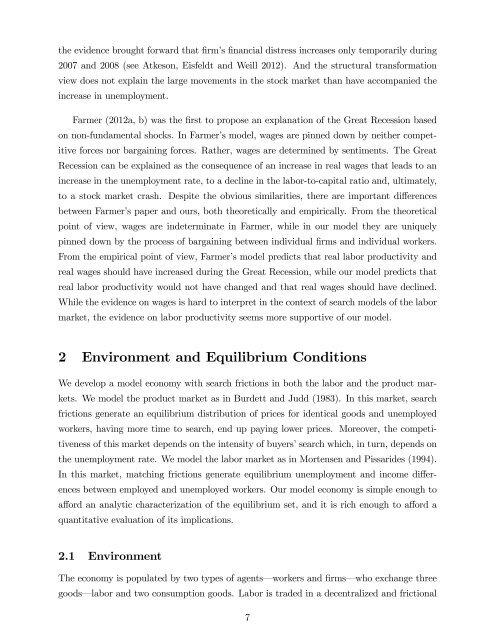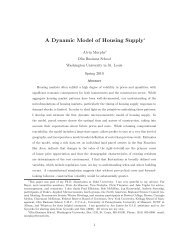Shopping Externalities and Self Fulfilling Unemployment Fluctuations*
Shopping Externalities and Self Fulfilling Unemployment Fluctuations*
Shopping Externalities and Self Fulfilling Unemployment Fluctuations*
Create successful ePaper yourself
Turn your PDF publications into a flip-book with our unique Google optimized e-Paper software.
the evidence brought forward that …rm’s …nancial distress increases only temporarily during2007 <strong>and</strong> 2008 (see Atkeson, Eisfeldt <strong>and</strong> Weill 2012). And the structural transformationview does not explain the large movements in the stock market than have accompanied theincrease in unemployment.Farmer (2012a, b) was the …rst to propose an explanation of the Great Recession basedon non-fundamental shocks. In Farmer’s model, wages are pinned down by neither competitiveforces nor bargaining forces. Rather, wages are determined by sentiments. The GreatRecession can be explained as the consequence of an increase in real wages that leads to anincrease in the unemployment rate, to a decline in the labor-to-capital ratio <strong>and</strong>, ultimately,to a stock market crash. Despite the obvious similarities, there are important di¤erencesbetween Farmer’s paper <strong>and</strong> ours, both theoretically <strong>and</strong> empirically. From the theoreticalpoint of view, wages are indeterminate in Farmer, while in our model they are uniquelypinned down by the process of bargaining between individual …rms <strong>and</strong> individual workers.From the empirical point of view, Farmer’s model predicts that real labor productivity <strong>and</strong>real wages should have increased during the Great Recession, while our model predicts thatreal labor productivity would not have changed <strong>and</strong> that real wages should have declined.While the evidence on wages is hard to interpret in the context of search models of the labormarket, the evidence on labor productivity seems more supportive of our model.2 Environment <strong>and</strong> Equilibrium ConditionsWe develop a model economy with search frictions in both the labor <strong>and</strong> the product markets.We model the product market as in Burdett <strong>and</strong> Judd (1983). In this market, searchfrictions generate an equilibrium distribution of prices for identical goods <strong>and</strong> unemployedworkers, having more time to search, end up paying lower prices. Moreover, the competitivenessof this market depends on the intensity of buyers’search which, in turn, depends onthe unemployment rate. We model the labor market as in Mortensen <strong>and</strong> Pissarides (1994).In this market, matching frictions generate equilibrium unemployment <strong>and</strong> income di¤erencesbetween employed <strong>and</strong> unemployed workers. Our model economy is simple enough toa¤ord an analytic characterization of the equilibrium set, <strong>and</strong> it is rich enough to a¤ord aquantitative evaluation of its implications.2.1 EnvironmentThe economy is populated by two types of agents— workers <strong>and</strong> …rms— who exchange threegoods— labor <strong>and</strong> two consumption goods. Labor is traded in a decentralized <strong>and</strong> frictional7
















